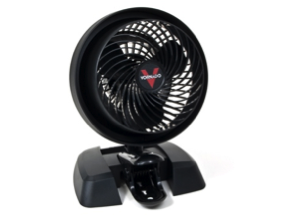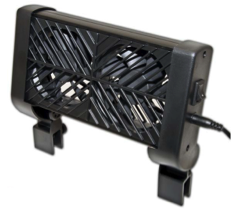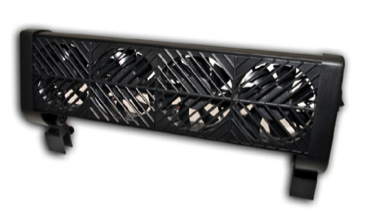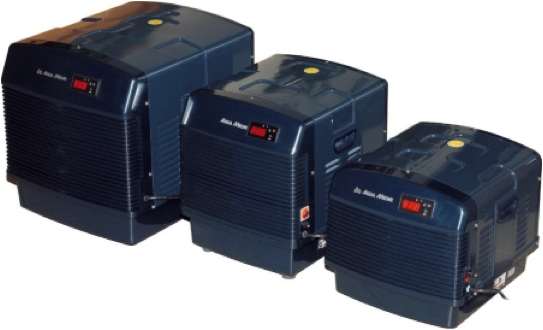|
There are many factors that can affect the temperature of your aquarium through the hot summer months. In this article we will explore what problems you may encounter and the various methods of fixing the issues. The temperature control is more important in reef/coral tanks than fish only setups but the issue needs to be taken into consideration with any aquarium setup you may have.
Position of your tank/aquarium:
If you tank is located in an alcove or similar position where it is included by several walls, this can increase the temperature of your Aquarium. Air is a great conductor of heat therefore restricting the flow of air around your tank can slowly increase the temperature in the summer.
The simplest way to overcome this is to position your aquarium in a location away from the window/natural sunlight with as much fresh air movement around your tank. Depending on the size of your house this option may not be possible.
Lighting up your tank:
Your aquarium lighting may make a dramatic effect on the water temperature of you aquarium as you are probably aware the HO T5’s and Metal Halide Aquarium lighting most commonly used, can become really hot. This is especially when you are running them both together. Some aquarium lighting units come with built in fans, especially with Halide units. The fans are quite efficient when it comes to keeping the ballast and the electrical components within the light unit cool however when it comes to keeping the water temperature down, it is a different matter. Metal Halides give out a lot of direct heat which is aimed towards your water usually with the help of an aluminium or tin reflector. Even if it is a cold day outside you will notice that the water temperature rises.
In regards to HO T5 aquarium lighting, these generally do not get anywhere near as hot as halides, however if you are running several tubes together you can find that they get quite hot. The heat, like the light is spread over the whole length of the tube therefore no specific spot is increasing in temperature as the little air movement you have will do a good job of removing this slight heat above your tank. In hot temperatures, T5 aquarium lighting can cause an increase in water temperature.
There are several options to reduce the heat provided by metal halide and T5 aquarium lighting. The cheapest method which can be most useful on the smaller reef tanks/nano tanks is a standard clip-on fan. You could invest in a general clip-on fan from your local DIY store for between £5-£10 which, or you can invest in a fan which is designed to clip onto your aquarium and to give the maximum effect for the wattage they consume. These range from £15-£50. Be careful if you buy these as some of the manufacturers make them look good but the output is poor and really wouldn’t help you if you were to increase the size of your tank.
Below I have put a couple of example of aquarium and clip on fans available on the market:
  
The negative side of these fans is that they will promote the rate in which your water evaporates from your tank therefore you would have to keep on top of the water levels throughout the summer, otherwise the salt content will increase thus causing other issues besides the temperature of your tank.
The next option is to invest in an aquarium chiller. These can prove to be quite expensive, especially if you have just spent a fortune on setting your tank up. They are quite efficient but yet again they will add to the overall running cost of your aquarium as they consume a lot more energy/electricity than the standard clip-on light. Chillers can be ok for the medium size aquarium but with larger aquariums it can be difficult to find a chiller large enough to do the job without it being constantly on. Chillers can vary between £200 for a budget range to £1200 for the high end range. They will also contribute quite a lot of noise which can be difficult to come to terms with especially if you are trying to relax.
Below are a couple of examples of aquarium chillers available on the market:

If you decide to buy a chiller please take the following points into consideration:
- Chillers will emit quite a lot of heat that they remove form you tank
- The must not be enclosed into a tight cabinet underneath the aquarium as they need breathing space around the heat exchanger.
- SAVE THE PACKAGING -You’ll need it for at least thirty days from the date you bought the unit. Chillers can be easily damaged in shipping, and often that damage will not be immediately apparent.
The third option is probably the most likely method of keeping your aquarium cool during the hot weather. The price of air conditioning units has come down dramatically over the past few years therefore a lot of households have invested in them. If you have one available it is wise that you use it in the room where you tank is located. Keeping the air in the room cool will in turn keep the aquarium cool too, however again these can be pretty expensive to run.
Natural sunlight entering the room from a window can increase the temperature of your aquarium and in the long term contribute to excessive algae growth due the long hours of sunlight directly on your tank in any 24 hours. Your corals and fish will thank you for cooler conditions at some point of the day.
An easy way to overcome this is to use blackout blinds or at least some kind of window blind which can help decrease the volume of sunlight entering the room.
With just a few hours of natural sunlight the aquarium temperature can increase a few degrees which can have negative effects on your tank.
Whichever method of cooling you chose to go for make sure you DO NOT unplug your aquarium heater!. A common mistake which aquarist can do over the summer time but at night times the temperature of your tank can plummet quite drastically. For this reason the heater must be plugged in at all times. Most heaters cut off when the temperature is at the required temperature.
What effects the drastic changes in temperature can have on your tank.
Mistakes are sometimes made to what actually caused distress to fish and how they die in the hot weather. It is not always the direct temperature of the water in your aquarium it is the effect the temperature has on the levels in your aquarium. The increased temperature can decrease the dissolved oxygen (DO) levels in your water, more with the salted aquariums than the tropical tanks as the salt effects these levels too. This is the reason in general your tropical tanks can tolerate higher temperature changes.
The stock levels in your tank can affect the oxygen levels therefore the higher the temperature, the less oxygen, therefore the more livestock you have in the tank the more oxygen you require to keep them alive.
Running your aquarium at the correct temperature will greatly reduce the amount of nuisance algae that grows in your aquarium which can build up on the glass front. When you clean this off most of it will die, in tern increase the amount of waste in your aquarium.
|

